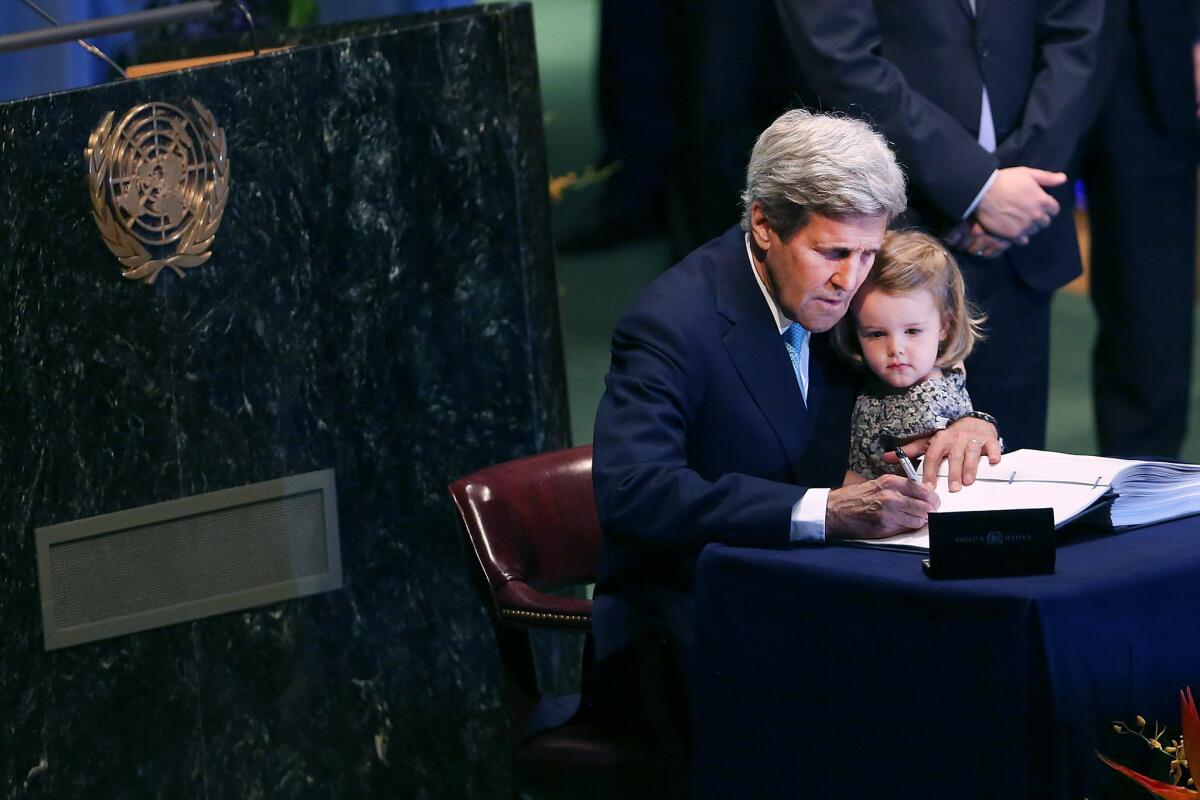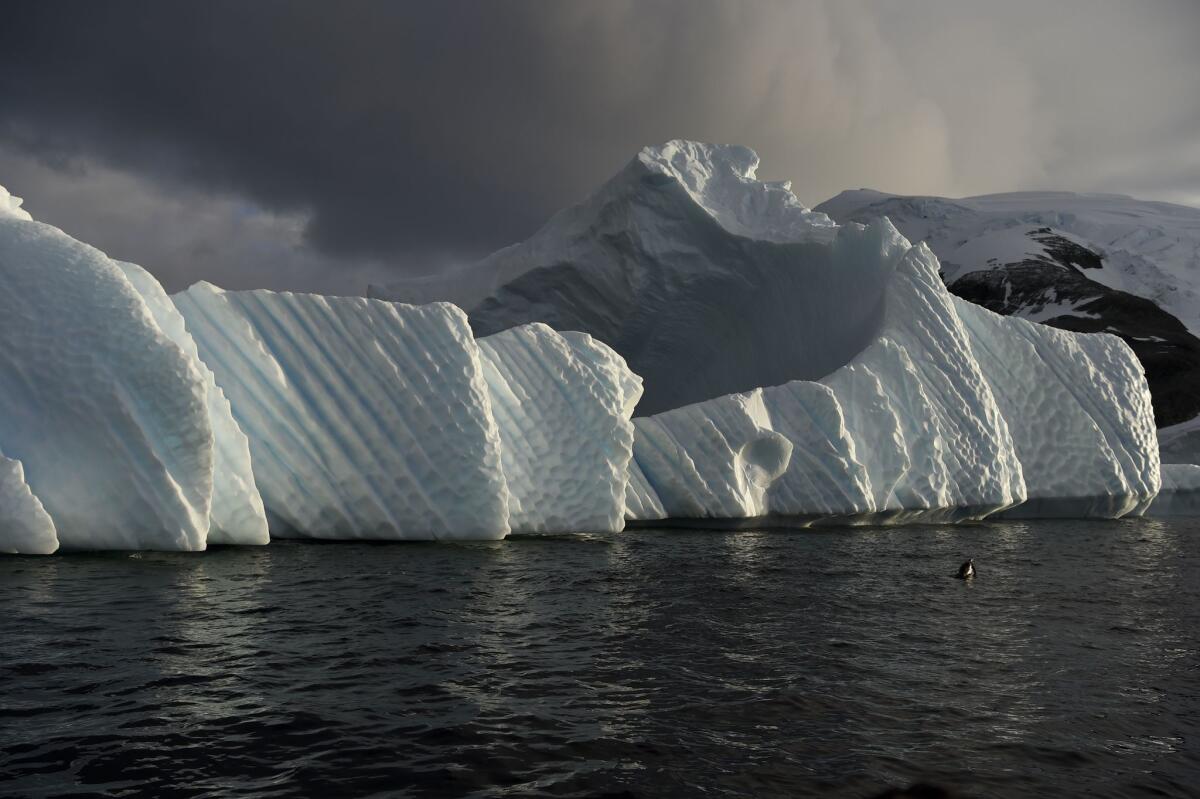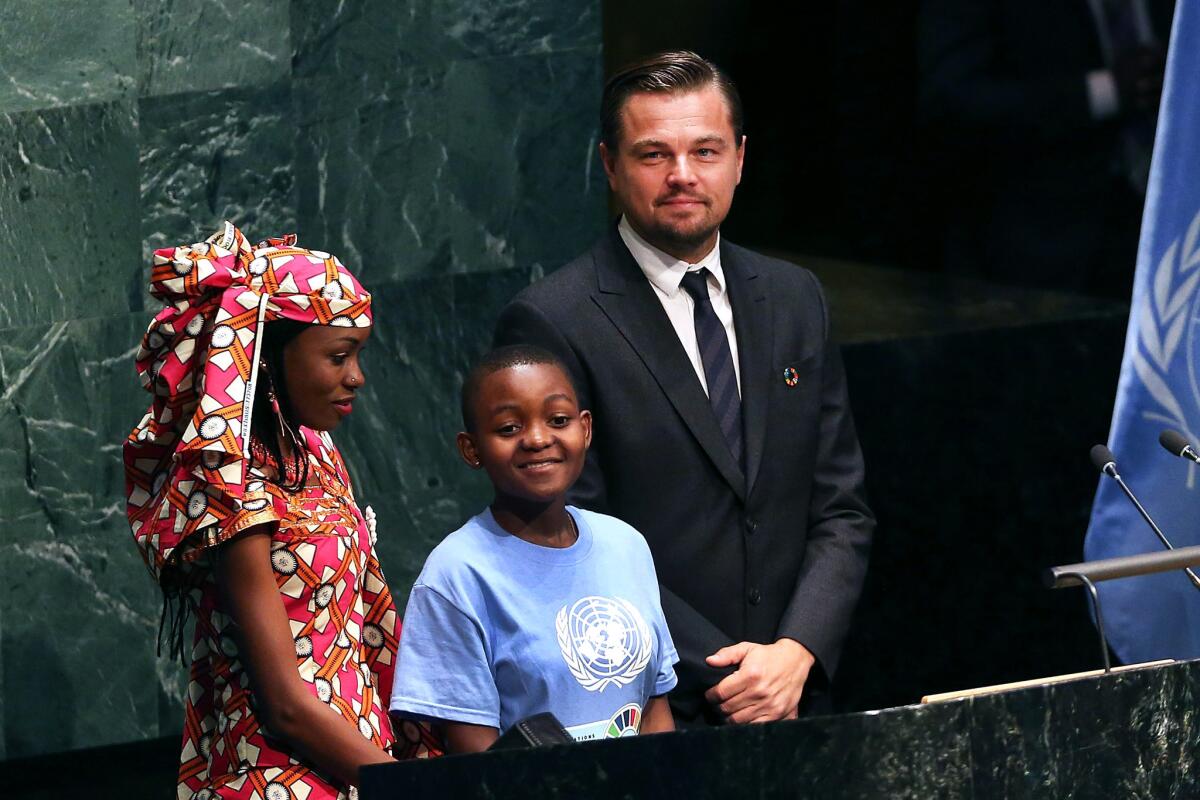At U.N., 175 nations sign landmark accord on global warming. ‘We are in a race against time’

U.S. Secretary of State John F. Kerry holds his 2-year-old granddaughter, Isabel Dobbs-Higginson, for the signing of the accord at the United Nations.
- Share via
Reporting from New York — In a striking declaration that the world is finally ready to change its polluted ways, global leaders gathered at the United Nations headquarters here to sign the landmark Paris climate accord, an agreement that’s seen as the blueprint for rescuing the planet.
The question is whether the plan will work.
Year after year, decade after decade, the planet has been getting warmer. This March was the warmest in recorded history. Scientists say the future will be filled with food shortages, drought, rising seas and extreme weather if bold action is not taken quickly.
“We are in a race against time,” said United Nations Secretary-General Ban Ki-moon.
In all, 175 nations signed the agreement Friday, the first day it could be signed. That is far more than had done so on a single day for any previous global agreement — but it still is also only a step toward the accord becoming international law.
For that to happen, at least 55 countries representing at least 55% of global emissions have to formally “join” or approve it within their national governments, some by executive action, others through legislative action. That process alone could take into 2017, though U.S. Secretary of State John F. Kerry suggested late Friday that the goal could be within reach this year. The United States plans to join the agreement this year, by executive action.
Even those who helped draft the accord acknowledge that its terms do not meet the goal it outlines to hold the increase in global temperatures to “well below” 2 degrees Celsius, or 3.6 degrees Fahrenheit, above pre-Industrial Revolution levels. Experts said the current agreement would hold the average temperature increase to perhaps just below 3 degrees Celsius.
But nearly a quarter of a century after international efforts to address climate change began, world leaders say this time, finally, momentum has shifted, and nations can confidently invest not in fossil fuels that create greenhouse gases but in clean, renewable energy — and still be assured that their economies will grow. Coal companies in the United States are going bankrupt. Access to lower-cost solar and wind power is increasing worldwide.
The accord, adopted by more than 190 nations who met outside Paris in December, relies on individual countries to set goals for reducing emissions and to regularly revise those goals upward every five years “to reach global peaking of greenhouse gas emissions as soon as possible.”

A melting iceberg on the western Antarctic peninsula.
The United States, which has committed to reducing its greenhouse gas emissions by 26% to 28% below its 2005 level in 2025, is among the countries that probably will have to revise its goals upward. Complicating matters, in February the Supreme Court issued a temporary stay to the Obama administration’s plan to reduce emissions from power plants.
Kerry told the U.N. on Friday that it misses the point to focus on the fact that the accord does not guarantee to hold temperature rise to below 2 degrees, or a stronger goal that many groups support of 1.5 degrees.
“The power of this agreement is the opportunity that it creates,” he said. “The power is the message that it sends to the marketplace. It is the unmistakable signal that innovation, entrepreneurial activity, the allocation of capital, the decisions that governments make, all of this is what we now know definitively is what is going to define the new energy future.”
On Friday, some countries vowed to exceed goals they outlined just a few months ago for reducing their emissions. China, the world’s largest emitter of greenhouse gases, said it intends to formally approve the agreement before it hosts the Group of 20 summit representing the world’s largest economies in September. China also reiterated its plans to establish a so-called cap-and-trade market that would put limits on how much carbon emissions industries can burn.
“The Chinese people honor their commitments,” Zhang Gaoli, the vice premier, told the U.N. “We will work hard to earnestly implement the Paris agreement.”
As Zhang left the podium, Ban, the secretary-general, said, “That’s great news.”
Prime Minister Justin Trudeau of Canada, the West’s new face of progressivism, prompted applause when he said his country would give money to help developing nations fight climate change and invest in clean energy — a crucial issue in negotiations leading to the agreement.
“They shouldn’t be punished for a problem they didn’t create,” he said.
The ceremony was held on Earth Day, an event started in 1970. Children filled the aisles of the U.N. and a brass ensemble from Juilliard played. Kerry signed the agreement while holding his granddaughter in his other arm. Leonardo DiCaprio addressed the delegates, quoting Abraham Lincoln, and a young woman from Chad described a once vast but now vanishing lake on which her country depends.
“True climate justice is renewable energy for all,” she said.

Leonardo DiCaprio stands with children at the United Nations signing ceremony for the Paris agreement on climate change.
Outside the United Nations, protesters said the accord falls far short of the action needed. About two dozen pretended to die, memorializing themselves with cardboard tombstones saying “R.I.P. Civilization” and “Killed by State Failure.”
But the accord was largely welcomed by conservation groups, and many said the large turnout of nations on the initial signing day was another important indicator that the problem was being taken seriously. The challenge, many said, will be to constantly press leaders to do more.
Alden Meyer, director of strategy and policy at the Union of Concerned Scientists, said major industrial nations at upcoming meetings should “phase out fossil fuel subsidies, shift investments away from high-carbon infrastructure like coal, and do more to help vulnerable communities deal with the mounting impacts of climate change.”
Tom Steyer, the billionaire environmental activist and philanthropist, praised the accord as “a moment of optimism as businesses, governments and citizens join together to chart a new course for our planet.” But he noted the increasing effects climate change is already having as motive enough to push for more ambitious action.
“Mother Nature,” he said, “has no plans to slow down.”
Next month, activists organized by 350.org plan demonstrations around the world against projects that produce and transport fossil fuels. Among the events planned is a march in downtown Los Angeles on May 14 to protest the city’s urban oil fields.
Yardley is a Times staff writer. Haller is a special correspondent.
ALSO
L.A. seeks to protect ‘wildlife corridor’ in Santa Monica Mountains
It’s Earth Day. So how is L.A. doing in creating a sustainable city?
It’s time for the California Air Resources Board to focus on low-income areas, lawmakers say
More to Read
Sign up for Essential California
The most important California stories and recommendations in your inbox every morning.
You may occasionally receive promotional content from the Los Angeles Times.










